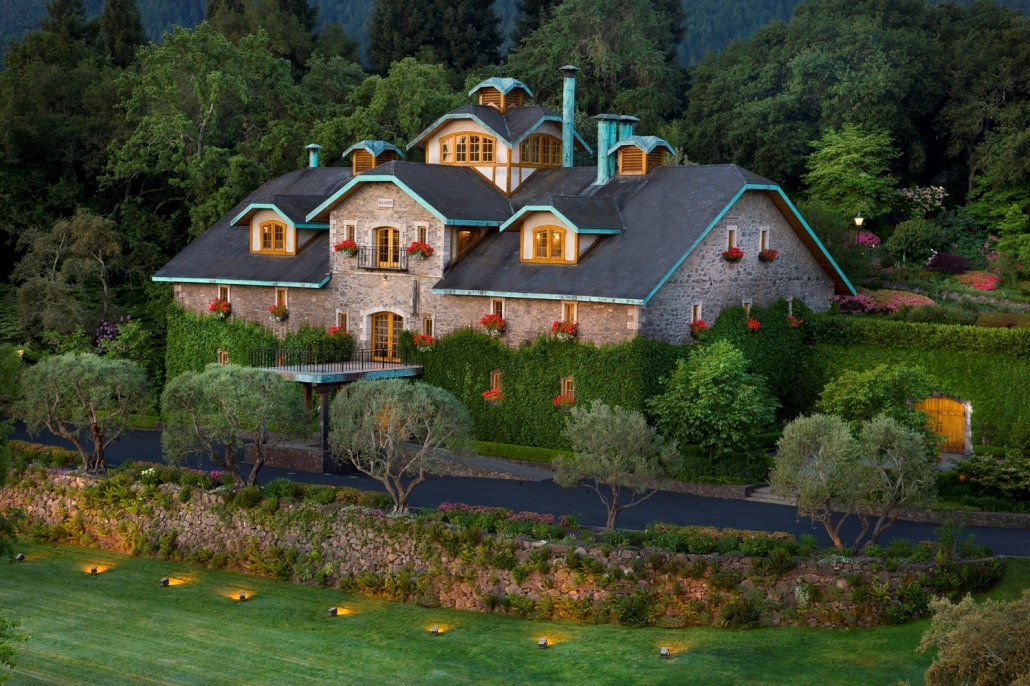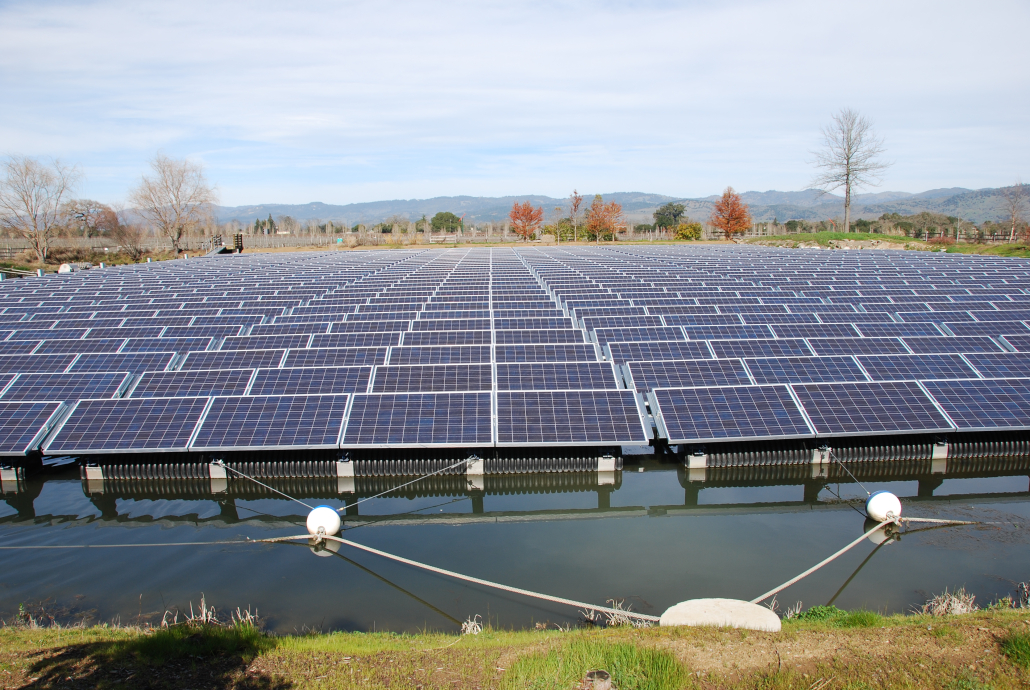In this paper, researchers quantify floating photovoltaic impacts on lake water temperature, energy budget and thermal stratification of a lake through measurements of near-surface lateral wind flow, irradiance, air and water temperatures at one of the largest commercial German facilities, situated on a 70 m deep dredging lake in the Upper Rhine Valley, South-West Germany.
Tag Archive for: floatovoltaics

By Anna Richmond-Mueller, NCAT Energy Analyst
At Far Niente Winery, respecting the land and all it provides is just second nature. Since 1979, their winemakers have been coaxing award-winning wines out of the grapes grown on their Napa Valley estate, but in 2005 began embracing their role as environmental stewards through their sustainability practices related to farming, winemaking, and renewable energy generation. Located on the Martin Stelling Vineyard in Oakville, Far Niente’s floatovoltaic system is at the forefront of the winery’s commitment to those sustainable practices and ethical winemaking.
When Far Niente decided to go solar, they faced challenges both unique and common to the agricultural world. Where many businesses may have chosen to place panels on the roof of their buildings, Far Niente’s old stone winery building is on the National Register of Historic Places, making it impossible to do so without violating regulations. Installing ground-mounted panels immediately around the heritage building was not an appealing solution either. After doing the math and realizing they would need to install over 2,000 panels to hit their energy production goal, they were faced with a tough choice: remove established cabernet sauvignon vines or get creative and take a risk. “Taking two acres out of cabernet production really hurts,” says winemaker Greg Allen. “By looking to the pond, it allowed us to maximize how many grape vines we were able to keep and still meet our goal.” These challenges ultimately culminated in the decision to build the world’s first grid-connected floating solar array, despite the lack of real-world success stories of floatovoltaic arrays at the time.
Developed by Thompson Technology Industries and installed by SPG Solar, the ambitious project went live in April 2008. A total of 1,000 Sharp 208 polysilicon panels were installed over the vineyard’s pond, covering just shy of a full acre. The panels rest atop pontoons anchored to the pond’s banks via marine-grade cabling attached to concrete columns. This setup allows the pontoons to rise and fall with changing water levels throughout the year. Rounding out the vineyard’s solar system are 1,300 ground-mounted panels adjacent to the pond. The system was originally installed with a 500-kilowatt central inverter, but that was replaced after 10 years with 12 SolarEdge string inverters. Together at peak output, the arrays generate roughly 407 kilowatts total with about 177 kilowatts coming from the floatovoltaic system alone.

Unsurprisingly, building such a system comes with a substantial financial commitment. The project’s total cost was $4.2 million upon completion, with an estimated payback period of 12 to 15 years. Fortunately, the net cost for Far Niente was significantly less, thanks to a $2.80/kW self-generation cash rebate from Pacific Gas & Electric, as well as a 30% federal tax incentive and accelerated depreciation tax benefit. The winery worked with Banc of America Leasing and Capital on a seven- year lease as well, which included a buyout option that would allow them to be the sole owners of the system. Far Niente did opt to purchase the array at the end of the seven years, and reports that the system paid for itself at around year 14 of operation.
With all the energy generated by the system, the winery is able to cover about 80% of its annual energy requirements, but that is far from the only benefit. The floatovoltaic array saves almost a full acre of viable land from being sacrificed for additional ground-mounted panels. Since this part of the vineyard is foundational to the winery’s cabernet sauvignon program, all that preserved space equates to thousands of dollars of bottled cabernet sauvignon revenue saved each year.
Additionally, there’s reason to believe that the panels’ positioning on top of the pond leads to increased efficiency when compared to the ground-mounted panels. Greg Allen has taken the surface temperature of the panels and found that those on the floating array can measure up to 5 degrees Fahrenheit cooler than their land-based counterparts. Because photoelectric conversion improves in cooler environments, keeping the solar panels at a lower temperature will increase the energy production efficiency when compared to the warmer panels on land.
A further boon to resource management is the array’s potential to reduce evaporation rates — a crucial win for a vineyard operating in an area seeing increasingly higher temperatures and more frequent drought conditions. While Greg notes that there is no completed study yet, he says, “In my mind, I think that the panels decrease the amount of evaporative loss from the pond.” He adds that it is difficult for the winery to quantify the potential amount of water saved, since there are systems both pulling water from and pushing water to the pond at various times. Currently, the pond serves the winery in several capacities, including as a fire- and frost-protection system, irrigation source, and as the recipient of all process wastewater from the winemaking facility. Three wells intermittently feed the pond, as well. Greg states that there is an ongoing research partnership between the winery and University of California Davis that will hopefully shed light on the shading and water conservation benefits, as well as the ecological impacts of the array.
When reflecting on the challenges the project presented, Greg says “Interconnection [to the grid] was a big one.” In order to meet their energy production goals, the entire system needed a 500-kilowatt inverter. The winery hit a roadblock with the project when they realized the main service transformer for the winery was only half that size. Far Niente’s utility provider requires that the main service transformer must be able to accommodate 100% of the energy produced by a solar system. “That spawned a massive project of its own,” Greg says, since the winery then had to replace their transformer to match the power rating of the inverter before they could bring the array online.
As the system approaches 15 years of use, they are noticing more individual panel failures. Greg says that the panels installed in 2007 are no longer commercially available to replace the failed panels, but there is a silver lining. He estimates around five more years of operation with their current set up, and then the winery could begin to look at the possibility of a major system overhaul. Over a decade of research and development has greatly increased the efficiency of today’s panels, providing the possibility of cutting their solar array footprint in half while maintaining the amount of energy produced on-site. “We could regain substantial amounts of vineyards,” he says. Should the winery choose to overhaul their entire system in such a way, the future revenue from the potentially recovered vineyard space could fund the cost of the improved system.

Looking back, Greg says a big challenge has been on the operations and maintenance side of owning the arrays. “Our main job is making and selling wine, and suddenly we’re put in the position of having to – on a daily basis – verify that the system is functioning and then initiate troubleshooting” when it’s needed. He points out that in the beginning, no one at Far Niente was an expert at what essentially became running a small power plant, but they had to develop that expertise in order to keep the system operating. With the possibility of a new system installation on the horizon, Greg speculates that partnering with a third party on a power purchase agreement could be an ideal solution for Far Niente. A power purchase agreement is an arrangement that allows a solar developer to install, operate, and own a system on a customer’s land. The customer is then able to purchase the electricity generated by the system directly from the developer, often at reduced rates. “It means that we would have on-site generation of renewable energy that we use,” he says, “and we would rely on the experts to maintain the system while we focus on growing grapes and making phenomenal wine.”
No decisions have been made yet as to whether Far Niente will pursue upgrading their system or move towards a power purchase agreement. Regardless of what path the winery will take in the coming years, Greg says they are really pleased with their decision to pursue onsite renewable energy generation and the overall performance of the solar arrays over the years. In particular, the winery’s ownership and staff have enjoyed being pioneers in the field of floatovoltaics. Far Niente’s years of renewable energy generation serve as an excellent example of how solar energy production can support a company’s efforts to implement sustainable measures while existing in harmony with agricultural operations.
